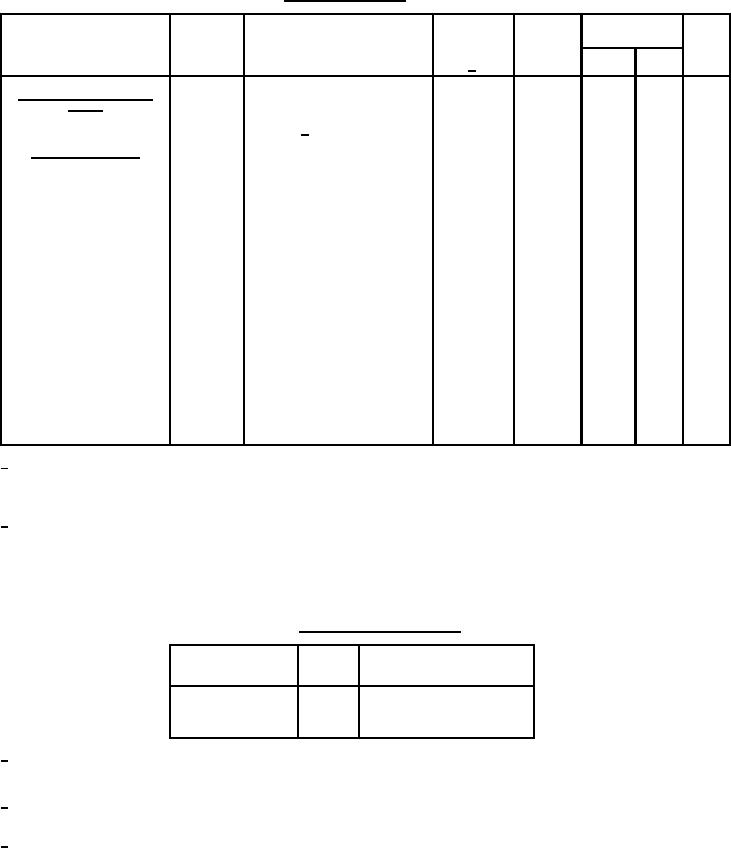
MIL-PRF-1/1725B
TABLE I. Testing and inspection - Continued.
MIL-STD-
Inspection
1311
Conditions
Acceptance
Symbol
Unit
Limits
Method
Level
5/
Min
Max
Conformance inspection,
part 3
----
----
----
----
----
Service-life guarantee
1/
----
Periodic-check tests
----
----
----
----
----
No voltage applied;
Shock, specified pulse
1042
acceleration = 15 G peak (min);
shock = 11 ms half-sine;
total impact = 6
(3 each X and Z axes)
Shock, specified pulse
end points:
V dc
-127
-95
Ec1
----
Electrode voltage (grid)
1261
-25
----
Ic1
----
1266
Total grid current
µA dc
----
----
----
----
No voltage applied;
1032
Vibration, mechanical
----
accel = 2 G peak (min);
F = 10 to 50 Hz, ascending only;
sweep t = 3 to 8 minutes; 1 sweep
each X and Z axes
Vibration mechanical
end points:
-127
-95
Ec1
----
1261
Electrode voltage (grid)
V dc
-25
----
Ic1
----
1266
Total grid current
µA dc
1/
The tube manufacturer warrants the tube for one year from the date of shipment, or 1,000 hours of filament life, whichever
first elapses. This warranty applies only when the tube is operated within the maximum ratings (see "Absolute ratings" of
MIL-PRF-1). A defective tube shall either be replaced, or at the option of the manufacturer a credit shall be made in the
amount of the original purchase price prorated on the basis of 1,000 hours of "filament-on" time.
2/
Minimum airflow requirements for incoming air at 40°C maximum at sea level, for operation below 30 MHz, are shown in table
II. Additional cooling may be required for operation above 30 MHz. In all applications, an air-system socket, such as the
EIMAC SK-1400 with air chimney such as the EIMAC SK-1406, or equivalents, should be used. Air should be directed in a
base-to-anode direction, and the values shown are for the tube and the SK-1400/SK-1406 combination with the air so
directed. In all cases, enough air should be used to prevent operation with the anode core and seal temperatures above the
maximum rating, and where long life and consistent performance are factors, cooling in excess of minimum requirements is
normally beneficial. Air should be applied before or simultaneously with the application of filament voltage, and may be
removed simultaneously with the electrode voltages.
TABLE II. Minimum airflow requirements.
Approximate pressure drop
Airflow
Anode dissipation
(in. H20)
(cfm)
(watts)
0.3
36.5
1,500
0.8
60
2,500
1.6
86
3,500
3/
During continuous Class AB1 operation, it is not likely that the absolute maximum ratings for the anode voltage (Eb) and
anode current (Ib) can be used simultaneously, as efficiency would have to be very high (75 percent) in order to avoid
exceeding the anode dissipation (Pp) rating of 3.5 kW.
4/
In all electrical tests involving application of filament voltage, an air-system socket and chimney may be used and forced-air
cooling is permissible.
5/
This specification sheet uses accept on zero defect sampling in accordance with MIL-PRF-1, table III.
3
For Parts Inquires call Parts Hangar, Inc (727) 493-0744
© Copyright 2015 Integrated Publishing, Inc.
A Service Disabled Veteran Owned Small Business